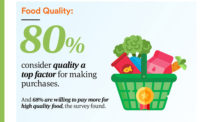Health-Conscious, ‘Climatarian’ Shoppers Want to Buy Organic
From packaged snacks, baked goods, and pasta sauces to more complex nutrition bars, fermented beverages, and plant-based milk analogs, organic fulfills multiple expectations

For many smaller processors, the slight increase in cost for organic ingredients is far outweighed by the interest in organic by today’s consumer.
PHOTO COURTESY OF: CHI Kitchen, LLC/Minnie Luong

Once associated closely with fresh and frozen ingredients, the number of canned organic food offerings has grown tremendously.
PHOTO COURTESY OF: Furmano Foods, Inc.

The ability to adapt and stay responsive to consumer, producer and buyer needs is a key part of organic’s continued growth and success.
PHOTO COURTESY OF: La Compagnie 2 Ameriks, Inc./GoGo Quinoa

Consumers seeking organic products have discovered an expanding selection across categories in the marketplace to choose from.
PHOTO COURTESY OF: P-R Farms, Inc./ENZO Olive Oil




Organic continues to be one of the fastest growing segments of US agriculture. The certification is practically a requirement to entry in the natural products space. From packaged snacks, baked goods, and pasta sauces to more complex nutrition bars, fermented beverages, and plant-based milk analogs, organic fulfills multiple expectations.
Food safety, natural and clean-label expectations, climate- and eco-friendliness—all are built into the organic label. Even ancillary designations, such as fair trade, functional, global, plant-based, and grain-free, can find a home under the organic label, when primary criteria are met.
Unlike other label claims, such as “natural” or “regenerative,” “USDA Organic” is the only federally defined and enforced eco-label in the marketplace. It is backed by third-party certification and provides traceability from the farm to the consumer.
The USDA National Organic Program (NOP) is responsible for setting and enforcing regulations for organic agricultural products that are either produced in the US or imported for sale in this country. Organic farming requires a whole-system approach to ensure that products are grown in a way that best supports a healthy, regenerative ecosystem. Organic handlers and processors are required to take special steps to make sure the organic ingredients are not commingled or contaminated with non-organic materials.
Processors also are required to follow legal restrictions on allowable materials and comply with specific labeling and composition requirements. In all cases, ecological management practices are required. Antibiotics, growth hormones, GMOs, and ionizing radiation are prohibited, as are artificial flavors, colors, and preservatives.
Six-Part Recipe—The Product Developer’s Toolkit
The biggest challenges for developers and manufacturers of organic products are sourcing certified organic ingredients and knowing what secondary ingredients may be permitted. The organic regulations clearly define the practices and ingredients that are allowed. To help, the Organic Trade Association offers a six-part recipe for successfully developing a product for the organic market called “Know Your Organic Product.”Part 1: Know Your Label
The first consideration in creating an organic product is deciding on the label objective. The label claim will largely dictate the required content of the product. Similarly, the formulation of the product will determine the label category the product will qualify for.In order to both label a product as “organic” and display the USDA Organic seal, the finished product must contain at least 95% organic-certified ingredients by weight/volume (excluding water and salt). The remaining 5% of ingredients and processing aids must be non-GMO and allowed based on the National List of Allowed and Prohibited Substances (see below). Additionally, to carry the “100% Organic” claim, a product must be made entirely of ingredients that are 100% certified organic. Processing aids also must be certified organic.
Part 2: Know the National List
Every product developer crafting an organic product must be fluent in the National List found in USDA’s organic regulations (Title 7 Part 205 of the Code of Federal Regulations). For prepared and processed products, the two sections of interest are § 205.605 and § 205.606.The “605” list covers non-agricultural substances, such as leavening agents, acidulants, buffers, stabilizers, emulsifiers, enzymes, natural flavors, microorganisms, gases, waxes, antioxidants, filtering aids, anti-caking agents, carriers, select gums, sanitizers, vitamins, and minerals.
The “606” list applies to the “95% Organic” label category and contains non-organically produced agricultural ingredients that are allowed only when organic alternatives are unavailable in the quality, quantity, and form needed to meet the specifications of a product.
Part 3: Know Your Process
Organic compliance can be categorized by either product or process. There are requirements for both. When you are making an organic product, the organic integrity of the ingredients must be protected and ensured from receiving to shipping, and through transportation to the end user. The proper equipment and a carefully managed process will prevent commingling or contamination with anything prohibited under the organic regulations, whether non-organic ingredients, sanitizers, or pest-control materials.Part 4: Know Your Supply Chain
Sourcing for organic relies on multiple sources and flexibility. Availability of ingredients can be inconsistent, and spot-buying is not foolproof. Some organic ingredients, especially herbs and spices, can be hard to find domestically. Ingredients might be available from non-domestic sources, but some countries have different standards for what constitutes organic. Non-domestic ingredients must be fully vetted with proper documentation to ensure they are compliant with the USDA Organic program.The key to sourcing organic ingredients is to develop relationships, know the supply chain intimately (upstream and downstream), maintain multiple sourcing options, firmly commit to a “just-in-case” manufacturing mindset, and invest in the organic farmer. The supply of organic food and beverage products is entirely dependent on the success of organic farmers.
Part 5: Know Your Certifier
Every USDA-accredited certifier is regulating to one USDA Organic standard. But, as in any business, each certifier is unique and specializes in certain services. When choosing a certifier, the following are the most important considerations:- Customer service/references
- Expertise and scope of accreditation/handling and processing expertise
- International/export program
- Reputation (the certifier is required to appear on your label)
- Cost and timeline for the certification process
Part 6: Know Your Resources
There are many resources available to help new and seasoned businesses take the plunge into organic. Below are a handful of recommended sites that should cover most issues.- Organic Trade Association–the one-stop shop for all things organic
- FindOrganic–comprehensive organic products and services
- The Organic Center–the science behind organic
- USDA National Organic Program–access to organic regulations and more
- Guide to Organic Labeling–know the product, know the label
- How to Get Certified–FAQs and step-by-step certification guidance
- Organic Integrity Database–search engine for organic operations
Looking to the future, industry members see mitigating the current supply-chain challenges as an opportunity. The goal is to rethink and move the needle on infrastructure and supply and demand issues that have long hindered stronger growth in organic. The commitment to go organic is a commitment to the planet.
Organic food, fiber, and regulatory expert Gwendolyn Wyard is the Vice President of Regulatory and Technical Affairs for the Organic Trade Association, the leading group focusing on the organic business community in North America. With a food science and technology degree from Oregon State University, Wyard provides key support to the OTA’s mission to “promote ethical consumerism, promoting and protecting the growth of organic trade to benefit the environment, farmers, the public and the economy.” She can be reached at GWyard@ota.com.
Growing Business
Organic produce has continued to grow at a prodigious rate, according to Robert Schueller, a director for Melissa’s World Variety Produce, Inc. “Since 2020, the category has nearly doubled in growth,” he notes. “Whereas about 10 years ago, organic made up about 5% of the total produce market, it now constitutes around 10%, and farmers are expanding their organic acreage as fast as possible. Consumers perceive organic produce to be safer and healthier, so we can expect the category to continue to grow at an accelerated rate.”Natural Progression
While the terms “natural” and “clean-label” currently have no legal definition or certification, processors already formulating products for these categories usually can make the transition to certified organic, having already avoided or phased out artificial or “chemical sounding” ingredients that are prohibited in organic products. Today, most suppliers can help processors make this transition with ease.Positive Growth
It was challenging for the $6.8 billion packaged and prepared foods category to maintain strong growth in 2021, after the frenzy of pantry and freezer stocking that took place in 2020. Yet, while frozen, refrigerated, canned, and dried prepared foods all declined, an uptick was seen in food service and deli, as consumers returned to in-store shopping and even started going back to the office. For 2022, all organic food categories are expected to return to positive growth. While fruits and vegetables, beverages, and snack foods—categories that maintained positive growth in 2021—are expected to see slightly slower growth than in 2021, condiments, packaged and prepared foods, and breads and grains will post notable growth after a year in the red, with expected increases of 3.4%–5.9% for condiments, 2.1%–4.4% for packaged and prepared foods, and 4.2%–6.2% for breads and grains. Overall, organic food sales are anticipated to grow at a rate of 3.5% to 5.5% in 2022, which is on par with the 4.6% growth reported in 2019, before the pandemic.Entering the Market
One practical option for entering the organic market is to consider the “made with organic ingredients” label category. This label requires products to contain at least 70% organic ingredients by weight/volume (excluding water and salt). Although not eligible for the USDA Organic seal, it is still a USDA organic-certified category, and the “made with” claim is permitted on the front label panel. This option provides more room for using permitted non-organic agricultural ingredients in the product.Looking for a reprint of this article?
From high-res PDFs to custom plaques, order your copy today!









